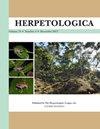Factors Affecting the Presence and Abundance of Amphibians, Reptiles, and Small Mammals under Artificial Cover in Southern California
IF 1.1
3区 生物学
Q2 ZOOLOGY
引用次数: 2
Abstract
Abstract: Artificial cover objects (ACOs) are known to attract small terrestrial vertebrates, but the actual parameters that attract species to ACOs can vary across geographic regions and climates. For this study ACOs were placed in coastal sage scrub and grassland habitats in southern California and surveyed weekly for small terrestrial vertebrates over a 4-yr period. We observed 1643 individuals of 34 taxa during 143 survey sessions totaling 16,312 ACO days. Overall species richness and abundances under ACOs were highest from February to April. Our results showed that the probability of encountering a reptile under an ACO was highest in February and March under large wooden ACOs containing moist soil, when temperatures under the ACO were relatively mild, and when minimum air temperatures were low. At the community level, encounter probabilities for small mammals were highest for large wooden ACOs and ACOs with low soil moisture, with several species differences. Amphibians of three species were only captured in low numbers primarily under wooden ACOs from November to March. Use of ACOs in research and monitoring is an inexpensive and simple way to document and capture a wide variety of small terrestrial vertebrates. Species richness and abundance can be maximized over short periods using ACOs and can be equally important for long-term monitoring, particularly once the factors that make ACO use effective for small terrestrial vertebrates of a certain region have been investigated.影响南加州人工覆盖下两栖动物、爬行动物和小型哺乳动物存在和丰度的因素
摘要:众所周知,人工覆盖物会吸引小型陆生脊椎动物,但吸引物种进入人工覆盖物的实际参数可能因地理区域和气候而异。在这项研究中,ACO被安置在加利福尼亚州南部的沿海鼠尾草灌木丛和草原栖息地,并在4年的时间里每周对小型陆生脊椎动物进行调查。在143次共16312天的ACO调查中,我们观察了34个分类群的1643个个体。2月至4月,ACOs下的总体物种丰富度和丰度最高。我们的研究结果表明,在2月和3月,在含有潮湿土壤的大型木制ACO下,当ACO下的温度相对温和,最低气温较低时,在ACO下遇到爬行动物的概率最高。在群落水平上,大型木制ACO和土壤湿度低的ACO遇到小型哺乳动物的概率最高,有几个物种的差异。从11月到3月,主要在木制ACO下捕获的三种两栖动物数量很少。在研究和监测中使用ACO是记录和捕获各种小型陆生脊椎动物的一种廉价而简单的方法。使用ACO可以在短时间内最大限度地提高物种丰富度和丰度,对于长期监测也同样重要,特别是在研究了使ACO对某一地区的小型陆生脊椎动物有效使用的因素后。
本文章由计算机程序翻译,如有差异,请以英文原文为准。
求助全文
约1分钟内获得全文
求助全文
来源期刊

Herpetologica
生物-动物学
CiteScore
4.60
自引率
0.00%
发文量
27
审稿时长
>12 weeks
期刊介绍:
Established in 1936, Herpetologica is a quarterly peer-reviewed journal serving herpetologists, biologists, ecologists, conservationists, researchers and the scientific community. The journal contains original research papers and essays about the biology of reptiles and amphibians, and covers many relevant topics including: behavior, conservation, ecology, genetics, morphology, physiology and taxonomy.
 求助内容:
求助内容: 应助结果提醒方式:
应助结果提醒方式:


